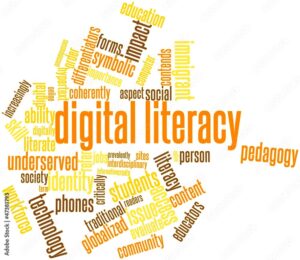 In my view, technology has not necessarily resulted in a more equitable society. However, it has significantly enhanced access to information and education. During the debate, the pro side argued that technology has led to a more equitable society because of its ability to provide access to education and medical services. Additionally, technology allows individuals who are unable to attend classes in person to participate in learning opportunities. However, as the opposing side discussed, this has its limitations. Limited access to technological tools, affordability challenges, and insufficient digital literacy present significant barriers that restrict the capabilities of medical professionals in providing telehealth services, as well as those trying to access education and information. A few classmates considered how these disparities became increasingly evident during the COVID pandemic, clearly highlighting differences in access to technology among students. Furthermore, inequalities in the access to the latest technology may intensify existing social status differences. Katia’s comment regarding the complexity and multiple facets of this issue is a very important argument. Providing universal access to the internet and technology is unlikely to address all challenges. Fixing these problems requires more than just throwing money at it. A complete plan that focuses on the underlying issues is crucial, and while money is necessary for implementation, it alone does not resolve the main problem.
In my view, technology has not necessarily resulted in a more equitable society. However, it has significantly enhanced access to information and education. During the debate, the pro side argued that technology has led to a more equitable society because of its ability to provide access to education and medical services. Additionally, technology allows individuals who are unable to attend classes in person to participate in learning opportunities. However, as the opposing side discussed, this has its limitations. Limited access to technological tools, affordability challenges, and insufficient digital literacy present significant barriers that restrict the capabilities of medical professionals in providing telehealth services, as well as those trying to access education and information. A few classmates considered how these disparities became increasingly evident during the COVID pandemic, clearly highlighting differences in access to technology among students. Furthermore, inequalities in the access to the latest technology may intensify existing social status differences. Katia’s comment regarding the complexity and multiple facets of this issue is a very important argument. Providing universal access to the internet and technology is unlikely to address all challenges. Fixing these problems requires more than just throwing money at it. A complete plan that focuses on the underlying issues is crucial, and while money is necessary for implementation, it alone does not resolve the main problem.
 Technology offers numerous advantages in supporting individuals with various disabilities, including those related to speech, hearing, and physical abilities, as highlighted in the article Digital Technology Is A Game Changer For Education Worldwide. Assistive technology offers benefits such as better communication, stronger numeracy skills, increased academic engagement, and greater social inclusion. It provides access to education for children regardless of their location or abilities. In the article, 6 Ways the New National Education Technology Plan Could Help Close Achievement Gap, Duncan stated “if the technology revolution only happens for families that already have money and education, then it’s not really a revolution.” This statement highlights reasons why it may not be accurate to claim that technology has resulted in a more equitable society. Technology has it advantages, but disparities remain. Until these disparities are addressed, technology will still benefit some individuals more than others in society. Another key point highlighted in the article is the importance for teacher training to support the transition toward integrating technology effectively into classroom practices.
Technology offers numerous advantages in supporting individuals with various disabilities, including those related to speech, hearing, and physical abilities, as highlighted in the article Digital Technology Is A Game Changer For Education Worldwide. Assistive technology offers benefits such as better communication, stronger numeracy skills, increased academic engagement, and greater social inclusion. It provides access to education for children regardless of their location or abilities. In the article, 6 Ways the New National Education Technology Plan Could Help Close Achievement Gap, Duncan stated “if the technology revolution only happens for families that already have money and education, then it’s not really a revolution.” This statement highlights reasons why it may not be accurate to claim that technology has resulted in a more equitable society. Technology has it advantages, but disparities remain. Until these disparities are addressed, technology will still benefit some individuals more than others in society. Another key point highlighted in the article is the importance for teacher training to support the transition toward integrating technology effectively into classroom practices.
 Digital inclusion, ensuring that everyone has access to technology, is essential if technology will ever lead to a more equitable society. However, it is essential not only that individuals have access to the technology, but also that they possess the skills required to use it effectively. In the blog, The Impact of Digital Inclusion on Social Equity, they also reiterate Katia’s sentiments that “the influence of digital inclusion on social equity is significant and complex.” Technology influences various aspects of our lives, including education, healthcare, and employment. The discussion in their blog highlights that pre-existing societal inequalities are often exacerbated by the digital divide, disproportionately impacting marginalized groups. They highlight the importance of implementing programs designed to reduce the divide, such as providing affordable internet access. They examine the extent to which internet access and digital skills can impact employment opportunities and participation in training programs. Based on my professional experience, all positions at our organizations are posted online, and a certain level of digital literacy is required to perform the job effectively. While many of us have internet access and technology, it is easy to overlook that a digital divide still exists in Canada. Even in developed countries, older adults with limited digital literacy, people from low-income backgrounds who cannot afford technology, and individuals living in rural regions without reliable internet access illustrate the existence of a digital divide.
Digital inclusion, ensuring that everyone has access to technology, is essential if technology will ever lead to a more equitable society. However, it is essential not only that individuals have access to the technology, but also that they possess the skills required to use it effectively. In the blog, The Impact of Digital Inclusion on Social Equity, they also reiterate Katia’s sentiments that “the influence of digital inclusion on social equity is significant and complex.” Technology influences various aspects of our lives, including education, healthcare, and employment. The discussion in their blog highlights that pre-existing societal inequalities are often exacerbated by the digital divide, disproportionately impacting marginalized groups. They highlight the importance of implementing programs designed to reduce the divide, such as providing affordable internet access. They examine the extent to which internet access and digital skills can impact employment opportunities and participation in training programs. Based on my professional experience, all positions at our organizations are posted online, and a certain level of digital literacy is required to perform the job effectively. While many of us have internet access and technology, it is easy to overlook that a digital divide still exists in Canada. Even in developed countries, older adults with limited digital literacy, people from low-income backgrounds who cannot afford technology, and individuals living in rural regions without reliable internet access illustrate the existence of a digital divide.
As mentioned in a previous blog post, the completion of my master’s degree would not have been possible without the support of technology. Not living in a larger centre with a university, technology has provided me an equal opportunity to access education. According to Annie Murphy Paul, the digital divide affects those who are already part of disadvantaged groups not individuals with adequate resources to access and use technology. In her blog, she discusses how children from different socioeconomic backgrounds use technology in different ways, a concept referred to as the digital Matthew Effect. Children with greater initial resources tend to gain more benefits from technology compared to those with fewer resources. Additionally, schools serving underprivileged students are often more likely to use technology for drill like activities rather than fostering engagement through creative projects. She states,
If every child has a computer, every child is starting off on equal footing. But though the sameness of the hardware may feel satisfyingly fair, it is superficial. A computer in the hands of a disadvantaged child is in an important sense not the same thing as a computer in the hands of a child of privilege.

This highlights that achieving equity involves more complexity than simply providing technology to everyone, equal access does not necessarily result in equitable outcomes. This argument was highlighted by the opposing group during the debate, and I believe it was convincing. Providing universal access to the internet and technology would promote equality, but true equity requires addressing individual needs beyond equal distribution of resources. If this digital divide is going to be reduced we need large digital companies and policymakers to address these issues.
 Both the research and the debate discussions appeared to have a consensus that rote memorization may not be the most effective approach, and that instructing students to memorize words is generally not considered the most beneficial teaching method.
Both the research and the debate discussions appeared to have a consensus that rote memorization may not be the most effective approach, and that instructing students to memorize words is generally not considered the most beneficial teaching method.  The opposing side claimed that teaching skills like spelling, cursive writing and multiplication tables is outdated and that teaching digital literacy, like coding, is essential. While technology offers many benefits and children need these skills for future jobs, the issue is not simply one of choosing between the two approaches. The methods used to teach these skills should evolve beyond simple memorization. However, this issue pertains to outdated instructional approaches rather than the inherent value of the skills themselves. These are different issues that should be addressed separately. According to the article provided by the other team, it is noted that the union leader,
The opposing side claimed that teaching skills like spelling, cursive writing and multiplication tables is outdated and that teaching digital literacy, like coding, is essential. While technology offers many benefits and children need these skills for future jobs, the issue is not simply one of choosing between the two approaches. The methods used to teach these skills should evolve beyond simple memorization. However, this issue pertains to outdated instructional approaches rather than the inherent value of the skills themselves. These are different issues that should be addressed separately. According to the article provided by the other team, it is noted that the union leader, 

 Digital inclusion,
Digital inclusion, 

 The article also addresses the concept that
The article also addresses the concept that 
 While I agree with
While I agree with 

 Compared to topic 1, I find this debate to be much more complex when trying to determine a position. Even adults struggle with social media, so expecting children to manage it in a healthy, balanced way seems unrealistic. Nevertheless, I appreciate that it allows people to connect with family and friends in ways that were previously not possible. I think of childhood friends that I lost contact with and wonder if these relationships might have been maintained had this technology been available during my youth. Both sides of the debate made some very valid points. From the agree side perspective that social media is designed to be addictive, it is evident that children spend less time playing outside. As well, the identities of children have become so intertwined with their presence on social media. From the disagree perspective, social media is not necessarily ruining childhood, and it is important for parents to model healthy digital habits. Additionally, the fact that children’s experiences are different from previous generations does not inherently make it negative.
Compared to topic 1, I find this debate to be much more complex when trying to determine a position. Even adults struggle with social media, so expecting children to manage it in a healthy, balanced way seems unrealistic. Nevertheless, I appreciate that it allows people to connect with family and friends in ways that were previously not possible. I think of childhood friends that I lost contact with and wonder if these relationships might have been maintained had this technology been available during my youth. Both sides of the debate made some very valid points. From the agree side perspective that social media is designed to be addictive, it is evident that children spend less time playing outside. As well, the identities of children have become so intertwined with their presence on social media. From the disagree perspective, social media is not necessarily ruining childhood, and it is important for parents to model healthy digital habits. Additionally, the fact that children’s experiences are different from previous generations does not inherently make it negative.

 and that mental health issues are a much more complex problem. One positive she noted was that younger people are talking about their struggles, but we lack resources to help support people with mental health issues. She mentions that while social media is not solely responsible for youth mental health issues, reforms are needed due to the significant time children spend on these platforms.
and that mental health issues are a much more complex problem. One positive she noted was that younger people are talking about their struggles, but we lack resources to help support people with mental health issues. She mentions that while social media is not solely responsible for youth mental health issues, reforms are needed due to the significant time children spend on these platforms. speakers, which can provide certain advantages. The accessibility of expertise in specialized fields represents a significant benefit offered by modern technology. My son, who is twelve, and a French immersion student, enjoys learning language. However, in his school French is the only additional language they offer. Through the benefit of technology, he has been utilizing the platform
speakers, which can provide certain advantages. The accessibility of expertise in specialized fields represents a significant benefit offered by modern technology. My son, who is twelve, and a French immersion student, enjoys learning language. However, in his school French is the only additional language they offer. Through the benefit of technology, he has been utilizing the platform 
 In my current role in Human Resources, technology plays a significant part in my daily activities, as I spend most of my workday engaged with tasks on my computer. I utilize a variety of digital platforms to coordinate tasks and manage documentation, relying heavily on Microsoft Word, Excel, Outlook, and Teams. Communication across our multiple locations is primarily facilitated through Teams, utilizing both text and video calls to ensure effective collaboration. Upon arriving at work, I begin by reviewing my email and Teams messages to identify any urgent issues that require immediate attention. The daily responsibilities on my desk are diverse; at present, the primary focus is on finalizing hiring plans, conducting interviews, and ensuring timely distribution of contracts to instructors.
In my current role in Human Resources, technology plays a significant part in my daily activities, as I spend most of my workday engaged with tasks on my computer. I utilize a variety of digital platforms to coordinate tasks and manage documentation, relying heavily on Microsoft Word, Excel, Outlook, and Teams. Communication across our multiple locations is primarily facilitated through Teams, utilizing both text and video calls to ensure effective collaboration. Upon arriving at work, I begin by reviewing my email and Teams messages to identify any urgent issues that require immediate attention. The daily responsibilities on my desk are diverse; at present, the primary focus is on finalizing hiring plans, conducting interviews, and ensuring timely distribution of contracts to instructors. While in-person interviews are preferred, they are not always possible. Given our six locations and the challenges presented by Saskatchewan’s weather (especially in the winter), we utilize platforms such as Teams and Zoom to conduct virtual interviews when geographic distance or scheduling concerns make in-person meetings impractical.
While in-person interviews are preferred, they are not always possible. Given our six locations and the challenges presented by Saskatchewan’s weather (especially in the winter), we utilize platforms such as Teams and Zoom to conduct virtual interviews when geographic distance or scheduling concerns make in-person meetings impractical.
Balanced discussion of technology’s role in shaping learning. It highlights both opportunities and challenges, encouraging thoughtful integration in education and…
Hi Jenna, Thank you for your thoughtful reflection. I am a new mom and I am concerned about the world…
Hi Jenna, Thank you for such an insightful post. Two points you made really stood out to me: the multigenerational…
Hi Nofisat, You raise an important point, and I wish I had a definitive answer. However, fostering awareness and engaging…
Hi Daegan, Thank you for your question. In my role within Human Resources, my primary responsibilities involve working with staff…